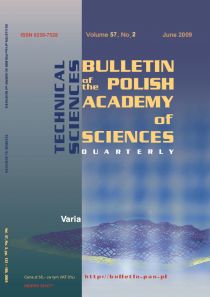POLISH ACADEMY of SCIENCES
TECHNICAL SCIENCES

Varia
| BULLETIN
of the
POLISH ACADEMY of SCIENCES TECHNICAL SCIENCES |
 |
|||
|---|---|---|---|---|
| Volume
57, Issue 2, June 2009
Varia |
||||
| Issue Index | Authors Index | Scope Index | Web Info | |
|
|
||||
| Aims&Scope, Subscription | Editors | Authors' guide | to read PDF files | mirror: http://fluid.ippt.gov.pl/~bulletin/ |
| pp 171 - 176 |
|---|
|
A stack multilayer high reflectance optical filter produced on polyester substrate with the PECVD technique |
|---|
| J. KOWALSKI, H. SZYMANOWSKI, A. SOBCZYK-GUZENDA, and M. GAZICKI-LIPMAN |
| The present work reports results of an effort to produce a stack multilayer optical filter on a poly(ethylene terephtalate) (PET) substrate, using a PECVD technique. Titanium dioxide type of material (n550 = 2.3) has been selected for high refractive index layers while that of silicon dioxide type (n550 = 1.4) served as low refractive index films. For a synthesis of the former material, titanium tetrachloride with an excess of gaseous oxygen was taken as a precursor system, and a mixture of oxygen and hexamethyldisiloxane (HMDSO) was used as a precursor system for a deposition of the latter one. The entire deposition process was carried out in the same parallel plate PECVD reactor, with all the consecutive layers being synthesized in one vacuum run. In the first part of the work, the deposition processes of both types of materials were optimized separately using polyester film as a substrate. The main goal of this step was to obtain high refractive index and low refractive index materials of good optical quality, remaining as close as possible to that of, respectively, titanium dioxide and silicon dioxide, without jeopardizing the optical quality of the polymer support. A construction of the filter was the next stage of the work. The design concerned high reflectance (HR) type filter consisting of five high refractive index layers, separated by four low refractive index films. Before an actual deposition, a performance of such system had been simulated, using the TFCalcTM 3.5 optical software. As a final step, the real structure, consisting of nine films, was produced, and the optical properties of the so obtained filter have been compared with those of the simulated system. |
| Key words: |
|
interference filter, titanium dioxide, silicon dioxide, polyester substrate |
|
|
| Issue Index | Authors Index | Scope Index | Web Info |
|---|---|---|---|
|
|
|||
| Aims&Scope, Subscription | Editors | Authors' guide | to read PDF files |
| Copyright
® Bulletin of the Polish Academy of Sciences: Technical Sciences
8 July 2009 |
|---|